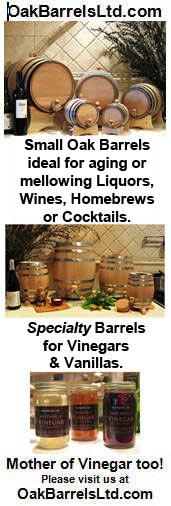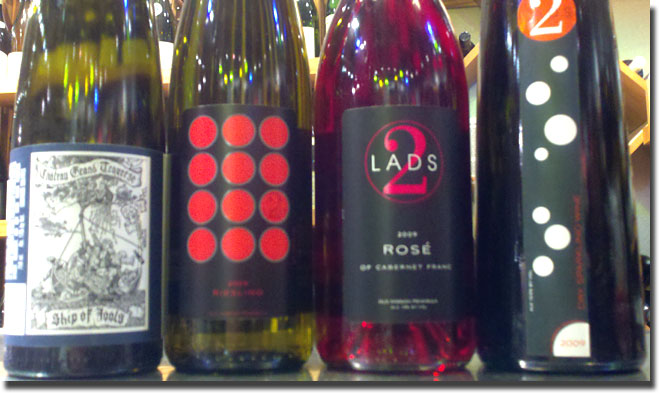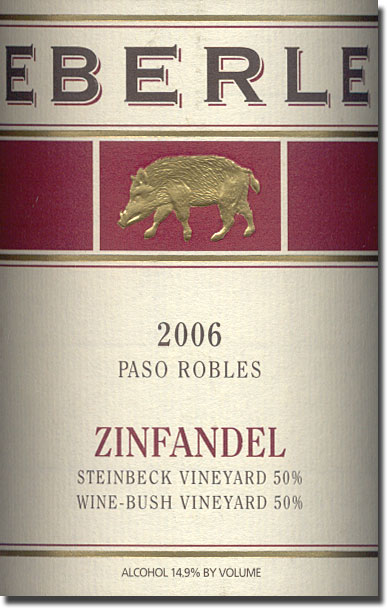Archive for the Tasting Notes from the Underground Category
A Country Neighborhood Red from Tablas Creek
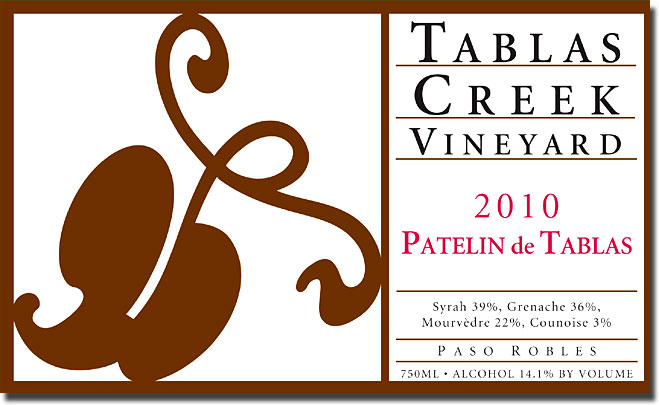 We’re always happy to try whatever comes our way from our friends at Tablas Creek Vineyard, because since we filed our first report on their wines, we’ve never had anything they’ve made that rated lower than a “very good,” and more often than not, the stuff is “really, really, really good.” We recently got to try a new bottling from TC, their Patelin de Tablas Rouge. You can read the full story on how this, and its pale counterpart, came to be on their blog, but the short story is that successive drought vintages cut into TC’s production, while a bad economy left many fine Paso Robles vineyards with grapes that they had a hard time selling. The happy solution to these problems was to create Patelin de Tablas; Patelin is roughly translated from the French slang for “country neighborhood.” In years with high production, wines would be comprised predominantly of estate fruit, while in leaner vintages, non-estate fruit from growers with good track records could be included. Most of these vineyards are planted with TC cuttings, and all are farmed sustainably, many through organic or biodynamic principles.
We’re always happy to try whatever comes our way from our friends at Tablas Creek Vineyard, because since we filed our first report on their wines, we’ve never had anything they’ve made that rated lower than a “very good,” and more often than not, the stuff is “really, really, really good.” We recently got to try a new bottling from TC, their Patelin de Tablas Rouge. You can read the full story on how this, and its pale counterpart, came to be on their blog, but the short story is that successive drought vintages cut into TC’s production, while a bad economy left many fine Paso Robles vineyards with grapes that they had a hard time selling. The happy solution to these problems was to create Patelin de Tablas; Patelin is roughly translated from the French slang for “country neighborhood.” In years with high production, wines would be comprised predominantly of estate fruit, while in leaner vintages, non-estate fruit from growers with good track records could be included. Most of these vineyards are planted with TC cuttings, and all are farmed sustainably, many through organic or biodynamic principles.
Read the rest of this entry »
Six from the Perrin Family
 We’re always happy to taste new offerings from the Perrin family of Château Beaucastel fame, as they rarely fail to satisfy. We weren’t at all disappointed with the six we tried most recently, and here’s the full Rhône-down.
We’re always happy to taste new offerings from the Perrin family of Château Beaucastel fame, as they rarely fail to satisfy. We weren’t at all disappointed with the six we tried most recently, and here’s the full Rhône-down.
2010 La Vieille Ferme Luberon Blanc, 13% alc.: Perhaps the most appealing La Vieille Ferme Blanc bottling we’ve yet tasted, showing clean, medium color and offering pretty white peach, lanolin and mineral flavors and aromas. Full bodied, with good cut and length, this pairs well with a variety of chicken and seafood dishes. Find this wine
2010 Perrin & Fils Côtes du Rhône Réserve Blanc, 13.5% alc.: Clean, medium color, with mineral-driven white tree fruit character; deceptively soft and a bit fat, but with enough acids to work nicely with pounded, pan-fried chicken breast. Full bodied, with good length; rich and satisfying, as it opens with air and warms in the glass. A blend of Viognier, Grenache Blanc, Roussanne and Marsanne. Temperature-controlled fermentation in tanks; aged in stainless-steel tanks. Find this wine
Read the rest of this entry »
Five from Stepping Stone
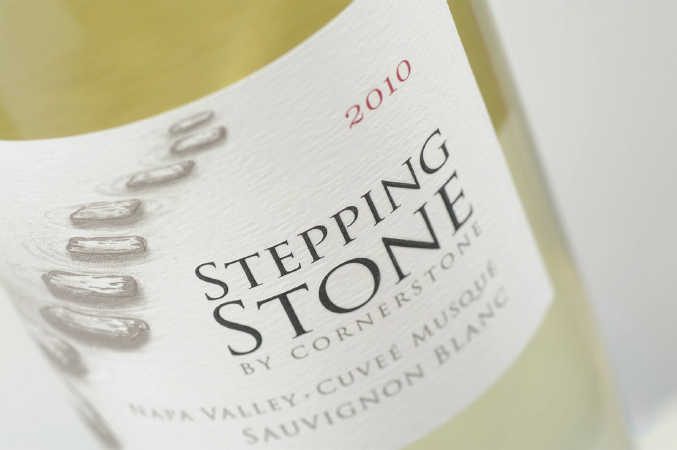 We’ve enjoyed pretty much everything that our friends at Cornerstone Cellars in Napa Valley have sent us to sample over the past few years, from both their flagship Cornerstone label and their second, Stepping Stone. Recently, we took possession of five of the current Stepping Stone offerings, and tried them over a series of evenings. We mostly liked what we tasted, but did find one selection excessively ripe for our tastes. Read on for our detailed impressions.
We’ve enjoyed pretty much everything that our friends at Cornerstone Cellars in Napa Valley have sent us to sample over the past few years, from both their flagship Cornerstone label and their second, Stepping Stone. Recently, we took possession of five of the current Stepping Stone offerings, and tried them over a series of evenings. We mostly liked what we tasted, but did find one selection excessively ripe for our tastes. Read on for our detailed impressions.
2010 Stepping Stone by Cornerstone Napa Valley Sauvignon Blanc Cuveé Musque, 13.5% alc., $18.00/bottle: Clean, medium color, with textbook clonal character and a subtle creaminess lurking quietly in the background that might give the mistaken impression that it saw some oak. Medium bodied, with flavors and aromas reminiscent of grapefruit, pine, lime and a hint of grassiness; medium-to-medium full bodied, with good cut and length. Pairs nicely with grilled salmon and red snapper. Sourced from a vineyard in St. Helena; underwent an extremely cool, gradual fermentation in stainless steel. “The Sauvignon Blanc Musque clone is responsible for some of the finest Sauvignon Blancs in California. Used by many wineries as a blending component, a few wineries (Stepping Stone by Cornerstone being one) are now using the Musque clone as if it were a distinct grape variety: Sauvignon Musque.” – Cornerstone Cellars Find this wine
Read the rest of this entry »
QPR Wines of Distinction
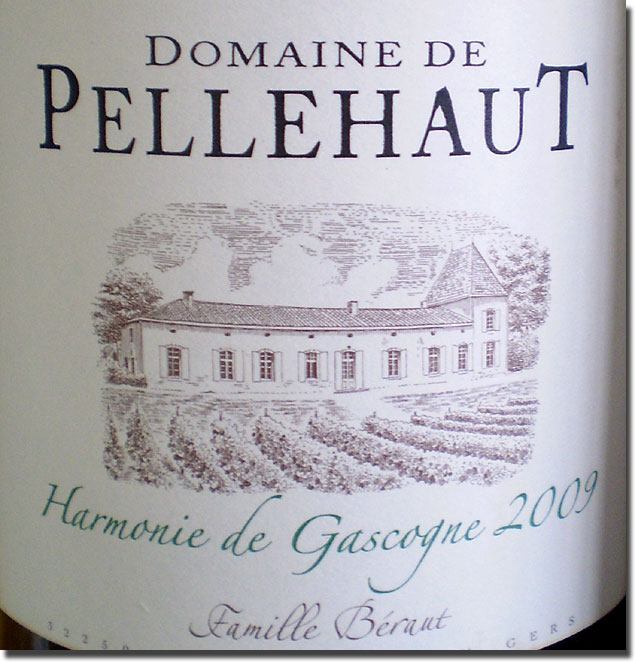 The sample boxes from our distributors were backing up at the retail operation in which I was, until recently, gainfully employed, so we divvied up the take and went our separate ways to taste and report back. Happily, the six I took home are all from our good friends at Wines of Distinction/J&J Importers and J et R Selections, and better yet, most were new vintages of old friends from producers that we’ve enjoyed over the years. They were tasted one by one, over a period of several evenings, and here are the notes that I shared with my colleagues.
The sample boxes from our distributors were backing up at the retail operation in which I was, until recently, gainfully employed, so we divvied up the take and went our separate ways to taste and report back. Happily, the six I took home are all from our good friends at Wines of Distinction/J&J Importers and J et R Selections, and better yet, most were new vintages of old friends from producers that we’ve enjoyed over the years. They were tasted one by one, over a period of several evenings, and here are the notes that I shared with my colleagues.
2009 Sacchetto Ca’ Berto Pinot Grigio delle Venezie, 12% alc., $8.99: Clean, medium color, with nice intensity of flavor and pure varietal character; medium bodied, with very well balanced acids and good length. This is a Pinot Grigio I could drink on a regular basis during the warmer months, and I can’t say that about that many that I’ve had. Find this wine
We’ve enjoyed the wines of Domaine du Pellehaut Côtes de Gascogne in the past; they offer great value for relatively little money, and these two follow the lead of those previous vintages.
2009 Domaine du Pellehaut Côtes de Gascogne Harmonie de Gascone Blanc, 12% alc., $8.99: Clean, medium color, with straightforward green apple and grapefruit flavors and aromas, underscored with some subtle minerality. Medium-to-medium-full bodied, with good acids and length; fairly rich and flavorful, very food friendly and a fine choice for an everyday white. Not flashy, just good, and that’s fine by me. Find this wine
Some Recent Michigan Wines with the Friday Night Regulars
Last week, I decided that it was high time to try some Michigan wines with the Friday night tasting group at the retail outlet in which I am gainfully employed. The bulk of the selections were from the 2 Lads Winery on the Old Mission Peninsula. Cornel Olivier and Chris Baldyga have established an impressive level of quality with their wares in a relatively short period of time, and I’m a fan, so here was an opportunity to try some of their newest selections with our intrepid band of regulars. We started things off with some bubbles.
2009 2 Lads Old Mission Peninsula Sparkling Pinot Grigio, 12.5% alc., $24.99: Clean and crisp; medium bodied, with very good mousse and excellent acidity. Bone dry green apple and grapefruit character, and very refreshing. Here’s what the lads have to say about this on their web site: “The cool (what? I meant cold!) summer of 2009 was perfect for sparkling wine production, and our Sparkling Pinot Grigio proves it. Produced in the traditional Champagne method, this sparkling wine underwent primary fermentation in tank before being transferred to the bottle for secondary fermentation (thus the beautiful bubbles!) It then aged 10 months en tirage (on the lees) before disgorging and finishing each individual bottle by hand.” Find this wine
Since the next selection maintains a solid presence on retail shelves in the area, I thought it would be both fun and instructive to see how it’s developing, so I included it in the mix.
Random Reds and Whites for the Friday Night Regulars
I host a weekly Friday night wine tasting at the retail outlet at which I am gainfully employed, and last week, I decided to abandon a more structured theme in favor of just sampling whatever odds and ends I thought our guests might enjoy. I also took the opportunity to pull the corks of a couple of things I hadn’t tried yet myself, so everybody won. Here’s the rundown on what we tried, starting with an old friend that we ran out of at Gang Central a few years back.
I still rue the fact that the last two distributors who carried Steve Edmunds‘ wines here in Michigan couldn’t do them justice, for whatever reason. Both are good independent companies, not the two or three monstrosities that have formed over the last several years through mega-mergers, and to be fair to them, the problem is likely more the fault of area retailers who simply didn’t know what to do with these great wines. Whatever the reason, I doubt that we’ll see the Edmunds St. John label in Michigan again anytime soon, and this was undoubtedly one of the last bottles to be found at retail anywhere around here, so I thought it would be a perfect choice to start things off.
Four from Rubicon Estate (or is it Inglenook?)
So I’m reading through this week’s Diner’s Journal by Eric Asimov in the New York Times and I see that Francis Ford Coppola has acquired “Inglenook,” the original name of Gustave Neibaum’s estate that he purchased in 1975. I also note that Coppola’s Rubicon Estate (previously known as Neibaum- Coppola) shall henceforth be known as Inglenook, which I find especially interesting, since I attended a “Rubicon Estates” tasting here in the Detroit area just last week, which goes to show how quickly things can sometimes change in the wine biz. It was also intimated last week at said tasting that a new winemaker would be taking over soon, following Scott McLeod’s departure last year, but that it was a big secret as to who that person would be. Now, it has been announced that Philippe Bascaules, who has spent the last 21 years at Château Margaux, will be taking over as estate manager and winemaker at Inglenook this summer. Big news indeed!
I attended one of these tastings back in 2004, then, as now, courtesy of our friends at Vintage Wine Company; at that time, the 2000 vintage of Rubicon was tasted blind alongside the same from Châteaus Haut-Brion and Mouton Rothschild. It was an interesting affair, though the Rubicon was quite obvious in its New World opulence. Driving to Ruth’s Chris Steak House in Troy last week, I wondered what the tasting format would be this time and if there would be another “taste-off” of sorts. As it turned out, it was a straightforward survey of four of Ingle…, er, Rubicon Estate’s most visible labels.
I didn’t pay much attention to the speaker’s by-rote talk about “Francis this,” “Francis that,” the estate and its vineyards or the wines, because I’ve either heard or read it all before; the information is readily available on the Rubicon Estate website, which I imagine will now have to be converted to the Inglenook website. (I hope they drop the flash format.) I focused on the wines, which were all pretty good, if a bit…; but wait a minute, I’m getting ahead of myself here.
As you might expect, we started off with a white.
Two 2007 Cornerstone Cellars Cabernet Sauvignons
Of the brilliant 2007 vintage in Napa Valley, it has been said that if you can’t make great wine in a year like that, you never will. And so it was with great anticipation that we took possession of two review samples of ’07 Cabernet Sauvignon from Cornerstone Cellars, a producer for whom we gain increasing respect for every time we try their wares. (You can read about previous encounters of the favorable kind here, here and here.)
We gave these two puppies a little over a week to settle down from their cross-country, journey, then invited our ITB friend Rebecca Poling over to see what they are all about. We paired them with all things grilled – lamb, potatoes and veggies – along with some richly caramelized onions and Kim’s freshly baked bread. Here are our impressions.
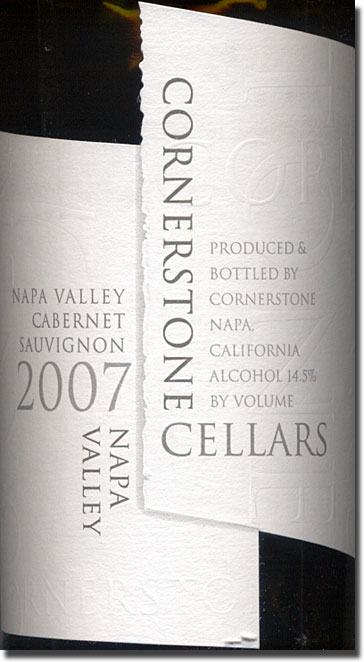 2007 Cornerstone Cellars Napa Valley Cabernet Sauvignon, 14.5% alc., $60: Clean, dark color, with a pretty nose of rich cassis, blackberry and black cherry; Rebecca adds an impression of chocolate covered blueberry cordial. Flavors generally echo on a full bodied, well-structured frame, but Ms. Poling commented on some grainy tannins, a slightly chalky mouth feel and drying tannins on the finish. While they are present, I found these qualities to present only a minor drawback, and I expect that this will age into a lovely Napa Cabernet with several years in the bottle. 100% Cabernet Sauvignon, blended from three Napa Valley AVA’s: 33% Howell Mountain (Ink Grade Block), 33% Oakville (Davis Block, Casanova Vineyards) and southern Napa County (Hardman Road). Each vineyard was harvested in late September and early October in perfect conditions. All lots were hand sorted and fermented separately. After a three day cold soak, tanks were inoculated with selected yeasts. Extended skin contact in the fermenter helped round out the tannins, with alcoholic fermentation taking about ten days and skin contact lasting up to fifteen days. Aged for 21 months in French Oak Barrels, 75% new. Find this wine
2007 Cornerstone Cellars Napa Valley Cabernet Sauvignon, 14.5% alc., $60: Clean, dark color, with a pretty nose of rich cassis, blackberry and black cherry; Rebecca adds an impression of chocolate covered blueberry cordial. Flavors generally echo on a full bodied, well-structured frame, but Ms. Poling commented on some grainy tannins, a slightly chalky mouth feel and drying tannins on the finish. While they are present, I found these qualities to present only a minor drawback, and I expect that this will age into a lovely Napa Cabernet with several years in the bottle. 100% Cabernet Sauvignon, blended from three Napa Valley AVA’s: 33% Howell Mountain (Ink Grade Block), 33% Oakville (Davis Block, Casanova Vineyards) and southern Napa County (Hardman Road). Each vineyard was harvested in late September and early October in perfect conditions. All lots were hand sorted and fermented separately. After a three day cold soak, tanks were inoculated with selected yeasts. Extended skin contact in the fermenter helped round out the tannins, with alcoholic fermentation taking about ten days and skin contact lasting up to fifteen days. Aged for 21 months in French Oak Barrels, 75% new. Find this wine
Four from Eberle
Over the years, we have had very little experience with the Paso Robles producer Eberle Winery, which is perhaps surprising, considering the fact that Gary Eberle was a co-founder of the Paso Robles Appellation in 1980, opened his winery in 1983 and has been an important player in that region ever since. We liked the two Zins that we tasted way back when we covered ZAP ’99 (look at those garish page colors!), but truth be told, their availability in Day-twah has been sporadic, so when we got our hands on four late model bottlings last week, we made a point of trying them over a four-day period, so as to spend some time getting to know each of them individually. The wines are made by Ben Mayo, who took over those duties in 2003, and as it turns out, offer good QPR for their respective prices.
Six from Le Cadeau
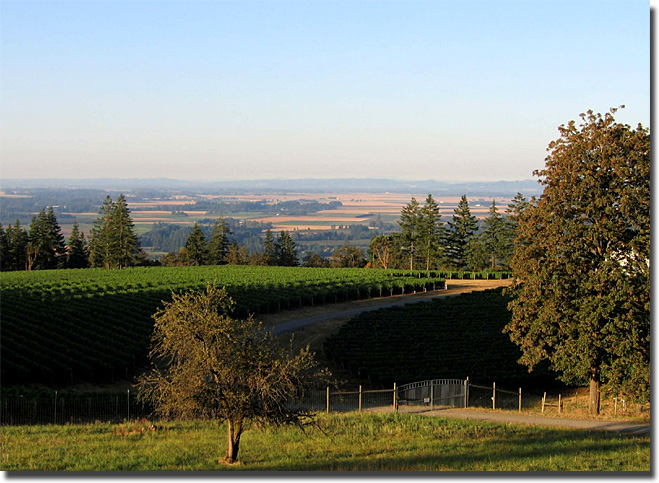 Tom Mortimer, co-owner the Willamette Valley Pinot Noir producer Le Cadeau is a self-described “wine geek.” In 1997, he and his wife Deb purchased 28 acres in the Willamette Valley on a high-elevation volcanic basalt hillside. They took two years to clear the land and, in 1999, planted the first in a succession of vineyard blocks, to a variety of Pinot Noir clones, with the first wines being produced in 2002. Tom describes Le Cadeau as “a winemaker-designated vineyard;” each of the top four bottlings is made by a different person. Mortimer explains that he has a lot of friends in the business, but they’re all very busy, so it’s all just sort of worked out for the best this way. There is also turnover occasionally; earlier vintages of the wines were made by the likes of Harry Peterson-Nedry, Cheryl Francis and Sam Tannahill and Tony Rynders. (click images to enlarge)
Tom Mortimer, co-owner the Willamette Valley Pinot Noir producer Le Cadeau is a self-described “wine geek.” In 1997, he and his wife Deb purchased 28 acres in the Willamette Valley on a high-elevation volcanic basalt hillside. They took two years to clear the land and, in 1999, planted the first in a succession of vineyard blocks, to a variety of Pinot Noir clones, with the first wines being produced in 2002. Tom describes Le Cadeau as “a winemaker-designated vineyard;” each of the top four bottlings is made by a different person. Mortimer explains that he has a lot of friends in the business, but they’re all very busy, so it’s all just sort of worked out for the best this way. There is also turnover occasionally; earlier vintages of the wines were made by the likes of Harry Peterson-Nedry, Cheryl Francis and Sam Tannahill and Tony Rynders. (click images to enlarge)
I had the opportunity to taste through the lineup of current releases from Le Cadeau with Tom this week, and I must say, I was impressed with them all. Mortimer is on a promotional tour of Michigan and stopped by with his local distributor, Jean-Jacques Fertal, of Eagle Eye Imports.
The wines all show a clean, ruby color, but beyond that, characteristics diverge somewhat. Prices listed are standard retail markups on special pricing being offered while Tom is in the neighborhood. We tasted through them rather quickly, as is necessary under such circumstances, but I was able to record these snapshot impressions.
